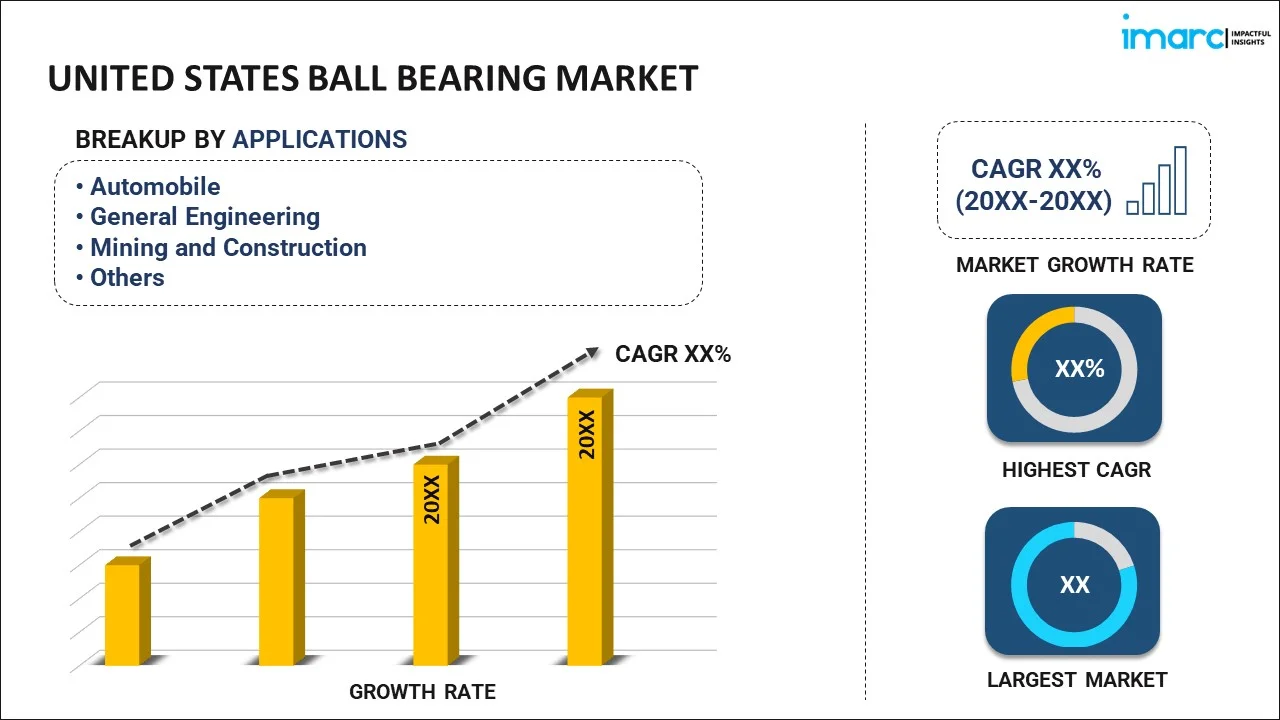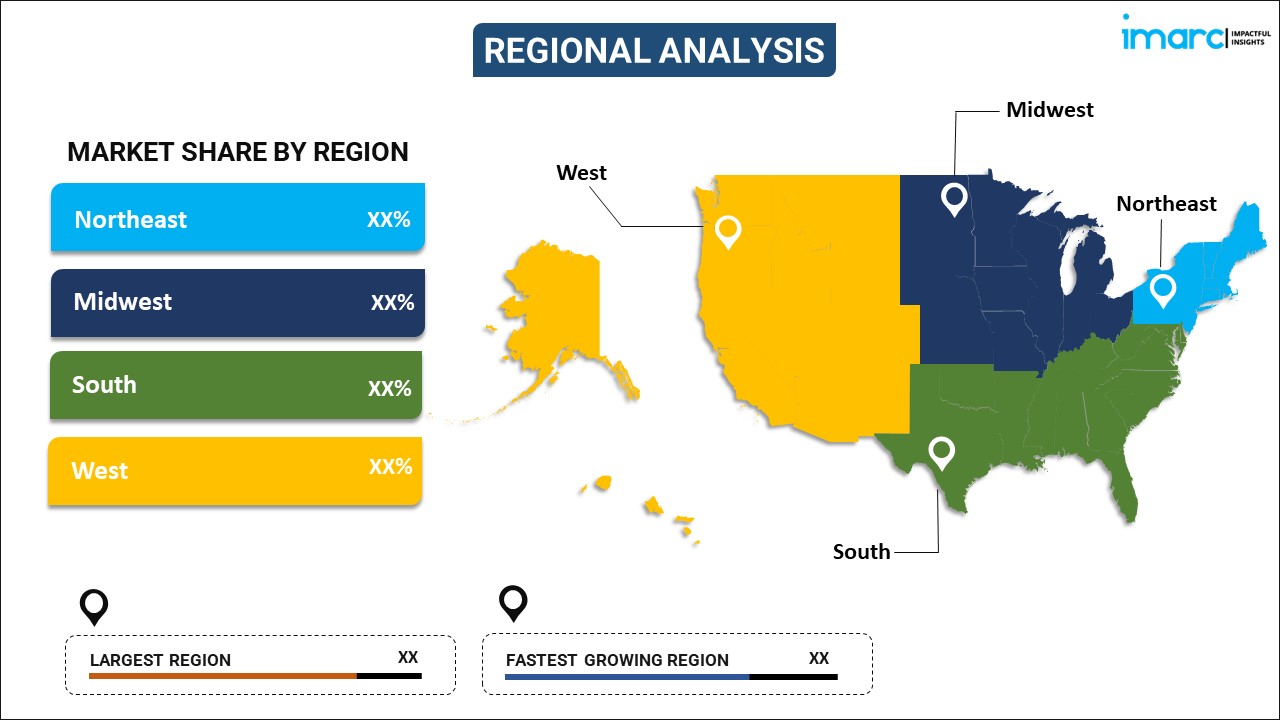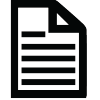IMARC made the whole process easy. Everyone I spoke with via email was polite, easy to deal with, kept their promises regarding delivery timelines and were solutions focused. From my first contact, I was grateful for the professionalism shown by the whole IMARC team. I recommend IMARC to all that need timely, affordable information and advice. My experience with IMARC was excellent and I can not fault it.
Read More
United States Ball Bearing Market Report by Application (Automobile, General Engineering, Mining and Construction, Railways, Aerospace and Shipping, Agriculture, and Others), and Region 2024-2032
Market Overview:
The United States ball bearing market size reached US$ 7.9 Billion in 2023. Looking forward, IMARC Group expects the market to reach US$ 10.7 Billion by 2032, exhibiting a growth rate (CAGR) of 3.3% during 2024-2032. The need for energy conservation, infrastructure development projects, and a shift towards smart and connected lighting systems, coupled with government support for the adoption of LED lights, are among the key factors driving the market growth.
|
Report Attribute
|
Key Statistics
|
|---|---|
|
Base Year
|
2023
|
|
Forecast Years
|
2024-2032
|
|
Historical Years
|
2018-2023
|
| Market Size in 2023 | US$ 7.9 Billion |
| Market Forecast in 2032 | US$ 10.7 Billion |
| Market Growth Rate (2024-2032) | 3.3% |
A ball bearing refers to a mechanical component that is essential in reducing rotational friction and supporting radial and axial loads. It comprises three main elements, including an inner ring, an outer ring, and balls. Ball bearings operate by using the rolling balls to distribute weight and mitigate stress points, enhancing efficiency in high-speed applications. Their spherical nature allows for the even distribution of load and smooth operation. They are commonly utilized across various industries, such as automotive, aerospace, electrical machinery, and precision medical instruments. By mitigating friction and wear, they provide longevity to machinery, thereby ensuring cost-effectiveness and operational excellence.
The United States ball bearing market is primarily driven by the bolstering economy and the subsequent increase in manufacturing activity. As industries such as automotive, aerospace, and construction expand their production, their demand for ball bearings naturally follows. Besides this, ongoing technological advancements and continuous development and integration of advanced materials and lubrication technologies that improve the performance and durability of ball bearings are creating a positive outlook for market expansion. Moreover, an increasing emphasis on energy efficiency and sustainability also contributes to the rising demand. Modern ball bearings can help reduce energy consumption across a range of applications, aligning with global sustainability goals and the push for lower carbon emissions. In addition to this, the expanding renewable energy sector, especially wind energy, wherein ball bearings are essential for wind turbine operations, is contributing to the market's growth. Furthermore, the implementation of favorable government policies aimed at revitalizing the manufacturing sector is aiding in market expansion.
United States Ball Bearing Market Trends/Drivers:
Ongoing technological advancements
Significant technological advancements are driving the U.S. ball bearing market by fostering better performance, durability, and longevity of these essential components. The introduction of ceramic materials, which reduces friction and withstands higher temperatures, allows ball bearings to function more efficiently in extreme conditions. Moreover, advanced lubrication technologies are reducing wear and tear, leading to decreased maintenance requirements and costs, thus helping improve overall productivity. Furthermore, innovations in sealing technologies safeguard ball bearings from contamination, extending their operational lifespan and ensuring the reliable performance of machinery. Besides this, the development of smart bearings equipped with sensors for monitoring performance, predicting failures, and enabling predictive maintenance are influencing the market growth. As technological boundaries continue to expand, the ball-bearing market is set to evolve alongside, meeting the increasingly complex needs of various sectors.
Economic recovery and revival of the manufacturing sector
The U.S., recovering robustly from the pandemic-induced economic downturn, is seeing a significant resurgence in the manufacturing sector. Ball bearings are vital in the automotive sector, from engines to wheels, and in the aerospace industry, they are essential for the manufacturing and maintenance of aircraft systems. Furthermore, the adoption of Industry 4.0 principles, including digitization, automation, and data exchange, is streamlining manufacturing processes and thereby boosting the demand for essential components such as ball bearings. As a result, the resurgence of these industries, coupled with broader manufacturing trends, is propelling product demand, spurring sectoral innovation and performance enhancements.
United States Ball Bearing Industry Segmentation:
IMARC Group provides an analysis of the key trends in each segment of the United States ball bearing market report, along with forecasts at the country and regional levels from 2024-2032. Our report has categorized the market based on application.
Breakup by Application:

- Automobile
- General Engineering
- Mining and Construction
- Railways, Aerospace and Shipping
- Agriculture
- Others
Automobile accounts for the majority of the market share
A detailed breakup and analysis of the market based on the application has been provided in the report. This includes automobile, general engineering, mining and construction, railways, aerospace and shipping, agriculture, and others. According to the report, automobile accounted for the largest market share.
Ball bearings are an essential component of the automotive industry, contributing significantly to the market growth. These elements reduce rotational friction and support radial and axial loads, enabling the efficient functioning of moving parts. Moreover, increasing product utilization in powertrain systems to facilitate smooth power transfer from the engine to the wheels by being used in transmissions, drive shafts, and differentials is propelling the market forward. Besides this, their use extends to engines, where they support mechanical components such as camshafts and crankshafts, enhancing efficiency and lifespan. Furthermore, ongoing technological advancements in ball bearings have been pivotal in electric vehicle (EV) development. Moreover, the automotive industry's shift toward lightweight and compact designs is fueling the demand for smaller, more efficient ball bearings. These trends, combined with increased automotive production and vehicle electrification, persistently drive ball-bearing demand in the sector.
Breakup by Region:

- Northeast
- Midwest
- South
- West
The report has also provided a comprehensive analysis of all the major regional markets, which include Northeast, Midwest, South, and West.
Competitive Landscape:
The United States ball bearing market represents a robust and diverse competitive landscape characterized by both domestic manufacturers and international players. Key players leverage advanced R&D capabilities and expansive distribution networks to maintain their dominance in the market. However, the market also includes smaller entities that focus on niche applications and localized services. The industry is being shaped by emerging trends, including the incorporation of advanced materials, integration of IoT for predictive maintenance, and increasing demand from industries such as automotive, aerospace, and wind power generation. Although well-established, this market presents considerable growth opportunities spurred by advancements in technology and industry-specific needs for higher precision and durability. The competitive dynamics are further influenced by trade policies, price competitiveness, and the manufacturers' ability to meet rapidly evolving customer requirements, providing ample opportunities for both established companies and innovative entrants to carve out their market shares.
The report has provided a comprehensive analysis of the competitive landscape in the market. Detailed profiles of all major companies have also been provided.
United States Ball Bearing Market Report Scope:
| Report Features | Details |
|---|---|
| Base Year of the Analysis | 2023 |
| Historical Period | 2018-2023 |
| Forecast Period | 2024-2032 |
| Units | US$ Billion |
| Scope of the Report | Exploration of Historical and Forecast Trends, Industry Catalysts and Challenges, Segment-Wise Historical and Predictive Market Assessment:
|
| Applications Covered | Automobile, General Engineering, Mining and Construction, Railways, Aerospace and Shipping, Agriculture, Others |
| Regions Covered | Northeast, Midwest, South, West |
| Customization Scope | 10% Free Customization |
| Report Price and Purchase Option | Single User License: US$ 3699 Five User License: US$ 4699 Corporate License: US$ 5699 |
| Post-Sale Analyst Support | 10-12 Weeks |
| Delivery Format | PDF and Excel through Email (We can also provide the editable version of the report in PPT/Word format on special request) |
Key Benefits for Stakeholders:
- IMARC’s report offers a comprehensive quantitative analysis of various market segments, historical and current market trends, market forecasts, and dynamics of the United States ball bearing market from 2018-2032.
- The research study provides the latest information on the market drivers, challenges, and opportunities in the United States ball bearing market.
- Porter's five forces analysis assist stakeholders in assessing the impact of new entrants, competitive rivalry, supplier power, buyer power, and the threat of substitution. It helps stakeholders to analyze the level of competition within the United States ball bearing industry and its attractiveness.
- Competitive landscape allows stakeholders to understand their competitive environment and provides an insight into the current positions of key players in the market.
The United States ball bearing market was valued at US$ 7.9 Billion in 2023.
We expect the United States ball bearing market to exhibit a CAGR of 3.3% during 2024-2032.
The rising demand for ball bearings across various industries, such as aerospace, transportation, mining, etc., as it offers low maintenance requirement, rigidity, high frictional resistance, and longer life span, is primarily driving the United States ball bearing market.
The sudden outbreak of the COVID-19 pandemic had led to the implementation of stringent lockdown regulations across the nation, resulting in the temporary closure of numerous manufacturing units for ball bearings.
Based on the application, the United States ball bearing market can be bifurcated into automobile, general engineering, mining and construction, railways, aerospace and shipping, agriculture, and others. Currently, the automobile sector holds the largest market share.
On a regional level, the market has been classified into Northeast, Midwest, South, and West.
Need more help?
- Speak to our experienced analysts for insights on the current market scenarios.
- Include additional segments and countries to customize the report as per your requirement.
- Gain an unparalleled competitive advantage in your domain by understanding how to utilize the report and positively impacting your operations and revenue.
- For further assistance, please connect with our analysts.

Purchase Options
Benefits of Customization
Personalize this research
Triangulate with your data
Get data as per your format and definition
Gain a deeper dive into a specific application, geography, customer, or competitor
Any level of personalization
Get in Touch With Us
UNITED STATES
Phone: +1-631-791-1145
INDIA
Phone: +91-120-433-0800
UNITED KINGDOM
Phone: +44-753-714-6104
Email: sales@imarcgroup.com
 Inquire Before Buying
Inquire Before Buying Speak to an Analyst
Speak to an Analyst  Request Brochure
Request Brochure  Request Customization
Request Customization



.webp)




.webp)












